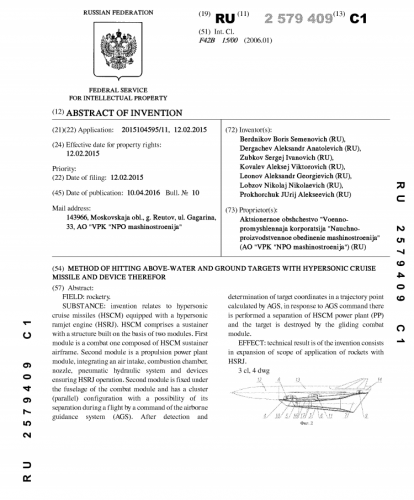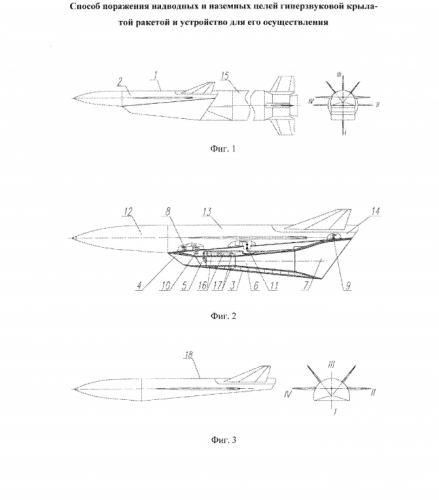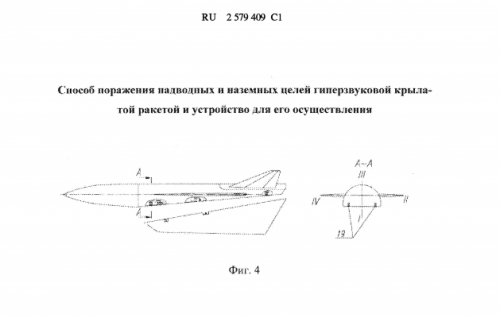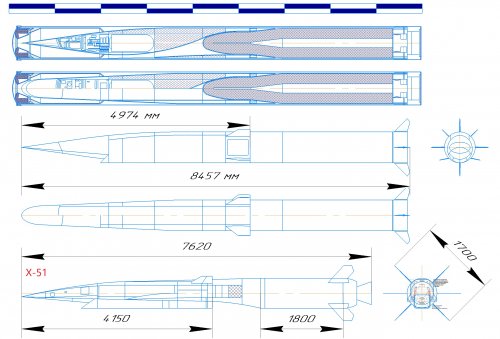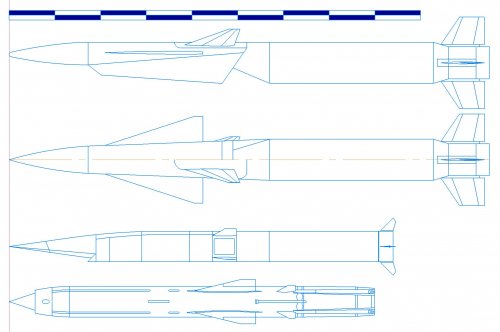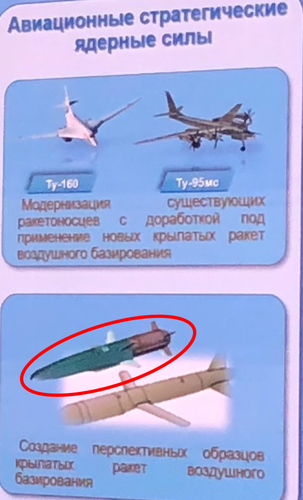The invention relates to a hypersonic cruise missiles (CMP), equipped with scramjet (scramjet). CMP contains marching step with design, built on the basis of two modules. The first module is a battle and is designed as a glider sustainer stage CMP. The second - unit sustainer propulsion system combines air intake, combustion chamber, the nozzle, the fluid system and devices that run the scramjet. The second module is mounted under the fuselage of the combat module packet (parallel) scheme, with the possibility of separating in flight by BASS team. After detection and target coordinates in the point of the trajectory, calculated onboard equipment control system (BASS) for BASS team produced the separation of the power plant (SU) CMP and defeat the purpose of planning is carried out combat unit. The technical result of the invention is to expand the scope of rockets from scramjet. 2N. 1 ZP f ly-4-yl.
The invention relates to the field of missile technology, and more particularly to a hypersonic cruise missiles equipped with scramjet (scramjet). The invention describes a method of using the device and hypersonic cruise missile (CMP), solves the problem of the combat mission for the defeat of ground and surface targets such missile.
Known hypersonic aircraft X-51, equipped with scramjet ventral air intake, which is a technology demonstrator. X-51 flight tests took place in order to develop technologies used in the creation of CMP. During the tests, the unit was separated from the aircraft carrier at a speed corresponding to 0.8M, and a height of 15.2 km, then he accelerated detachable solid-starter-boost stage to the speed corresponding to M = 4.5-4.8. Then launch the scramjet was carried out, after which the device scored a height of about 30 km and was flying, maintaining a speed of about 5M. After completion of the flight at a given altitude test plan provided off of the power plant and the fall of the unit (based on the 17th AIAA International Space Planes and Hypersonic Systems and Technologies Conference).
This method is the use of the aircraft and its equipment to the technical nature the most similar to the subject matter of the invention, despite the fact that the X-51 makers were hesitant tasks directly hitting the ground or sea targets, as the entrance into the dense layers of the atmosphere of the overclocked to an altitude of Mach number = 5 and a vehicle with a scramjet is associated with the probability of sequential destruction of its powerplant and airframe before reaching the destruction of the object.
The described invention is designed to maximize the combat potential of the CMP with the scramjet and aircraft, discussed above, is accepted as the closest analogue.
To solve the problem of the use of missile weapons in the promising samples scramjet propulsion system requires (SU), which will fully meet all the demands placed upon it.
A feature of the cruise trajectory missiles scramjet is the presence of the main high-altitude flight section, for example, at a height of H = 30 km at a constant speed corresponding to Mach 6. Before hitting surface or ground object CMP must be reduced to the height of the location of the target (for surface targets 10 m, and for the land at altitudes from 0 to 4000 m) and at the same time produce a decrease of flight speed to reduce aerodynamic loads and provide acceptable handling characteristics.
It should be noted that the calculation mode for the scramjet propulsion are flight conditions at high altitude with the maintenance of the settlement cruise velocity, and the need to reduce the height and speed creates intractable technical problems related to the fact that:
- The engine is designed to perform hypersonic cruise flight at high altitude, is not able to continue to work on the low-altitude areas of the trajectory, coupled with a decrease in flight Mach number, it follows that to the ground or surface target missile must be approached with engine inoperative;
- Stability and controllability characteristics CMP inoperative scramjet significantly deteriorate, it becomes possible loss of stability;
- There is also the danger of the destruction of the scramjet designs due to increased pressure in the running of the engine while reducing the CMP with the cruise altitude before hitting the target.
Availability of off-design conditions for the scramjet high altitude causes that enable flight CMP requires regulated power unit (SU), in which the air intake flow of the engine and nozzle are configured to change their shape in a wide range of geometric parameters. Such decisions need to be implemented to create a scramjet performance in a wide range of parameters of the incoming flow. Changing the shape of the air intake, combustion chamber and engine nozzle is only possible with the use of sophisticated control devices.
The above device should provide a work SU wide range of speeds and altitudes by continuously adaptive adjustment to the conditions of flight gas path geometrical parameters and supply fuel substantially from SU transforming scramjet supersonic flow in SC conventional subsonic flow from the ramjet.
The solution of such a complex technical and technological tasks under tight weight and size restrictions placed on weapons systems, it seems inappropriate.
The object of the invention to provide a method for applying CMP to combat scramjet to destroy ground and surface targets within the constraints imposed on the flight propulsion rocket.
This object is achieved by the fact that in contrast to the known method defeats the purpose of the capital master plan, which consists in removing the missile at a given altitude and flight speed starter-boost stage (CPC), the CPC office, launching cruise scramjet, active flight at the design height in the direction of the goal, search , seizure and destruction of the target, in the claimed invention, after detection and target coordinates in the point of the trajectory, calculated onboard equipment control system (BASS) for BASS team is made off scramjet followed by separation of the power plant by marching step by tripping piroustroystv and defeat the purpose carried out planning combat unit, correcting its trajectory according to the homing system.
The proposed method makes it possible to realize the combat capabilities of the missiles by firing at a target while minimizing approach to it due to the high speed of the march CMP flight.
Branch power plant will reduce the drag and hence to increase the duration of the planning area and combat unit will be able to withstand high overload permissible, and hence have better controllability. Also SU compartment lead to a significant decrease in firing module effective surface scattering and hence to reduce its visibility, which is especially important at the approach to the target.
For carrying out the process of hitting the target in the known device of hypersonic aircraft, comprising solid-starter-booster stage (CPC) and the marching step with ventral air intake scramjet liquid hydrocarbon fuel, comprising SU containing air intake, combustion chamber, nozzle, the fluid system and devices that run the scramjet, the claimed invention there is provided marching step by CMP to build on the basis of two modules, the first of which is to combat and is designed as a glider sustainer stage CMP and the second - in the form of unit sustainer propulsion system, combining the all of the above device SU and fixed under the fuselage of the combat module packet (parallel) scheme, with the possibility of separating in flight by BASS team. This module propulsion system (IAS) mounted under the fuselage of the combat module piroustroystvami, and to ensure supply to the power plant unit propulsion fuel and control commands it is connected with the combat unit discontinuous hydraulic and electrical connectors.
The proposed CMP device allows to solve the problems associated with the creation of hypersonic combat unit through a specially designed rocket, allowing it to separate from the marching power plant, thereby avoiding the need to make a flight with a scramjet to deliberately off-design conditions. In addition, the union into a single unit air intake, combustion chamber, nozzles, heat exchanger and the fluid system will significantly reduce launch weight of CMP, as its design will be perceived only loads acting on the dispersal areas and active (working with scramjet) flight.
The modular design will allow SU to make it an autonomous ground tests and increase the reliability of the whole installation.
The essence of the apparatus illustrated in FIG. 1 ÷ 3. FIG. 1 is a perspective view of the starting step CMP, Fig. 2 - layout sustainer stage CMP. FIG. 3 shows a general view of the combat unit. FIG. 4 illustrates the division of the combat unit and MSU after powered flight portion where a section A-A shows the location piroustroystv fuselage (19).
Start CMP step (1) is made by the normal aerodynamic scheme with plyusoobraznym plumage starter-booster stage.
The stage contains the starting kickoff-booster stage and marching gear (2) with a two-keel empennage and wings mounted on the fuselage having a longitudinal plane of symmetry. Under the fuselage of the combat unit sustainer stage mounted in parallel module power unit (3) with an air inlet (4), the pylon assembly (5), combustion chamber (6) and the nozzle (7). Securing local government by means of piroustroystv (8 and 9), giving a control command to the power plant by means of a discontinuous electrical connector (10) and power is marching fuel through the bursting gidrorazem (11).
The forward fuselage of the combat module (12) located onboard equipment control system. On average, the fuselage compartment (13) has a fuel tank and the payload bay. By the tail section (14) is mounted starter-booster stage (15).
Said device operates as follows.
After separation from the launch vehicle produced CDS and CMP concluded on march speed and altitude. Further downstream from the CDS, and simultaneously starts the supply pilot fuel into the combustion chamber of the power plant from the tank, located in its housing (16). Coming from this fuel tank, igniting using pyro (17), runs the power plant and prepare it for operation on the main fuel, placed in the middle section of the fuselage. Next, the scramjet launch and the rocket begins to cruise flight.
After the end of the active portion of the flight propulsion system is separated from the combat unit. Plot trajectories associated with the planning and the defeat of targets, overcoming a combat unit (18).
Thus, the present invention makes it possible to extend the scope of rockets from scramjet.
1. A method for hitting surface and land targets hypersonic cruise missile (CMP), which consists in removing the missile at a given altitude and flight speed starter-boost stage (CPC), the CPC office, launching cruise scramjet (scramjet), active flight at the design height towards the target, search, capture and destruction of the target, characterized in that, after detection and target coordinates at a point of the trajectory, computed onboard equipment control system (BASS) at BASU command produced off scramjet followed by separation of the power plant from the march stage through operation piroustroystv and defeat the purpose of planning is carried out combat unit, correcting its trajectory according to the homing system.
2. The apparatus for performing the method hitting surface and land targets hypersonic cruise missile, comprising a solid-starter-booster stage (CPC) and the marching step with ventral air intake scramjet liquid hydrocarbon fuel, comprising a power unit (SU) comprising an air inlet, a combustor, a nozzle, a fluid system and devices that support the operation scramjet, characterized in that the sustainer stage CMP is based on two modules, the first of which is to combat and is designed as a glider sustainer stage CMP, and the second - as a module sustainer propulsion system that combines all of the above device SU and fixed under the fuselage of the combat module packet (parallel) scheme, with the possibility of separating in flight by BASS team.
3. The apparatus of claim. 2, characterized in that the propulsion unit (ISU) mounted under the fuselage piroustroystvami combat unit and connected thereto discontinuous hydro and electrical connectors.
http://www.findpatent.ru/patent/257/2579409.html


